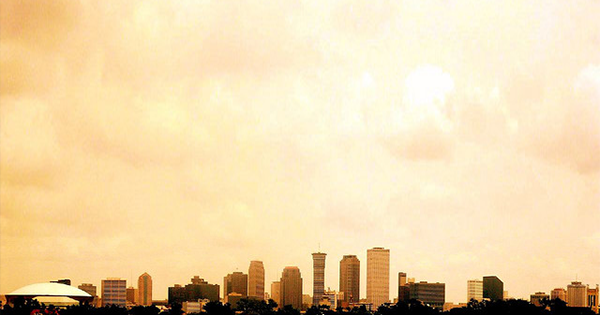Walled City
It will take more than a catastrophic storm surge to tear down these fortifications

In 2002, three years before Hurricane Katrina, a now-retired civil engineer from Louisiana State University named Joe Suhayda was interviewed by NPR’s Daniel Zwerdling as they stood in the French Quarter.
Suhayda’s idea? Build a vast wall—three stories high and 12 miles long—around the Quarter and several adjacent neighborhoods to protect against the inevitable flooding after a big hurricane. The wall would preserve a national architectural treasure, but would also serve as a refuge against rising waters for those unable to flee—Suhayda called it a “community haven wall.”
This is how he imagined the scenario playing out: just before a storm, fleeing citizens arrive by bus, foot, and cars. The winds pick up; rains come slashing in. “Some people are probably falling down… and needing help,” he says. Teams go out and aid them in reaching the gates. And then—boom—the storm hits, the gates close, those outside the portcullis are left to fend for themselves. As scenarios go, the only things missing are the crossbows and vats of boiling oil to pour on the marauding Visigoth winds.
While strange and a bit fanciful (and some of it just wrong—the French Quarter was part of the 20 percent of the city that didn’t flood in Katrina), this is essentially how the city already protects itself from hurricanes. It’s all pretty elemental and medieval: build a wall, hunker behind it.
The New Orleans Levee District oversees more than 100 miles of levees and floodwalls, along with 200 floodgates; many more miles of levee protect surrounding towns. Levees are, in essence, cutting edge 15th-century technology: piles of dirt capped with grass or concrete to prevent erosion. Much has been done to refortify the city in the past decade. I-beams have been replaced with sturdier T-beams in some floodwalls; levees have been raised and re-armored; new flood gates and pumps have been installed at the mouth of the drainage canals to keep the storm surge at bay.
The city has advanced quite well in hard defenses against a future storm, although the system hasn’t yet been seriously tested.
But perhaps it’s even better equipped in what might be called soft defenses—of applying more creative approaches to preparation, evacuation, and resilience in the event of another catastrophic storm.
To understand that, think of what’s changed since the attacks of 9/11, which occurred five years before Katrina. The obvious changes have been in airports, with TSA checkpoints serving as the re-armored wall against terrorism. Like peasants seeking protection, long lines of shoeless people file through narrow portals into a citadel called “airside,” controlled by sentries lacking lances but amply stocked with latex gloves.
But a far broader change occurred in the national psyche when planes met steel. Prior to the World Trade towers falling, everybody was taught how to respond in the event of a hijacking. Sit still. Stay calm. Obey instructions. Wait for ransom to be paid. Trust that you’ll get home eventually.
Now, if anyone tries anything in flight with box cutters or the like again, the last thing many passengers will do is sit still and obey instructions.
This is the soft defense—the change in attitude among millions of people—and it serves as an impressive fortification against similar episodes.
New Orleanians have also made a broad adjustment. Of course, citizens no matter how committed can’t turn back the winds and waters. But they now understand that keeping the city alive and resilient is on them.
Big voices spoke up after Katrina with big plans for the city—creating vast green spaces where homes once stood; bringing in national developers like KB Homes because only they had the resources and know-how to rebuild massively; putting “cranes on the skyline” to construct downtown towers.
The loud voices faded; softer voices persisted and got things done—creating new organizations to make sure the levees were safe and neighborhoods were preserved. And putting hands to hammer and rebuilding the city one house at a time.
Among the more visible signs of soft defense has been the raising of houses — hundreds around the city have now been boosted above the flood line. For several years after the storm, it was not uncommon to see homes tottering above sidewalks on Jenga-like stacks of wood awaiting a foundation.
But the strongest soft defense may be a deep understanding that the city and its culture—its music, food, architecture, and web of community supporting it all—could be lost forever if the hard defenses fail. New Orleans is now infused with a hyper-vigilance against this happening again, and moves with alacrity and ferocity against anything threatening it—even 100-mph winds and 25-foot storm surges.
The walls of Jericho came falling down with the blowing of a ram’s horn. The walls of the new New Orleans have risen, if invisibly, thanks to the blowing of hundreds of tubas, trumpets, and trombones.

